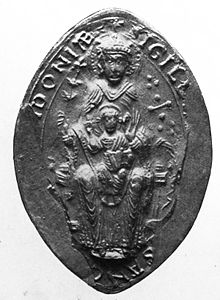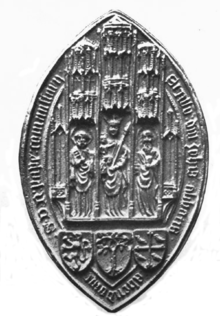Abbots


The historic abbots, right up to the dissolution of the abbey in 1538, are as follows:
| Name | In office | Comments |
|---|---|---|
| Saint Æthelwold of Winchester | c. 955 – c. 964 | later Bishop of Winchester [1] |
| Osgar | c. 964 – 984 | [1] |
| Eadwine | 985 – 990 | [1] |
| Wulfgar | 990 – 1016 | [1] |
| Æthelsige | 1016 – 1018 | [1] |
| Æthelwine | 1018 – 1030 | [1] |
| Siward | 1030 – 1044 | [1] |
| Æthelstan | c. 1044 – 1047/1048 | [1] |
| Spearhafoc | c. 1047/1048 – 1051 | a famous goldsmith, later Bishop-Elect of London, who absconded with a large treasure |
| Rodulf | 1051 – 1052 | [1] |
| Ordric | 1052 – 1066 | [1] |
| Ealdred | 1066 – 1071 | [1] |
| Adelelm | 1071 – 1083 | Norman abbot [1] |
| Rainald | 1084 – 1097 | Norman abbot [1] |
| Faritius | 1100 – 1117 | Norman abbot [1] |
| vacant | 1117 – 1121 | [6] |
| Vincent | 1121 – 1130 | [6] |
| Ingulph | 1130 – 1159 | [6] |
| Walkelin | 1159 – 1164 | [6] |
| vacant | 1164 – 1165 | held by the king [6] |
| none | 1165 – 1175 | held in commendam by Godfrey, bishop of St Asaph [6] |
| vacant | 1175 | [6] |
| Roger | 1175 – 1185 | [6] |
| vacant | 1185 – 1186 | vacant for half a year [6] |
| Alvred | 1186 – 1189 | [6] |
| Hugh | 1189/1190 – c. 1221 | [6] [7] |
| Robert of Hendred (Henreth) | 1221 – 1234 | [7] |
| Luke | 1234 – 1241? | [7] |
| John de Blosmeville | 1241 – 1256 | [7] |
| William of Newbury | 1256 – 1260 | [7] |
| Henry of Frilford (Frilleford) | 1260 – 1261 | [7] |
| Robert of Hendred | 1261 – 1289 | [7] |
| Nicholas of Culham | 1289 – 1306 | [7] |
| Richard of Bishops Cleeve | 1306 – 1315 | [7] |
| John of Sutton | 1315 – 1322 | [7] |
| John de Canyng (Canynges) | 1322 – 1328 | [7] |
| Robert of Garford | 1328 – 1332 | [7] |
| William (of Cumnor (Comenor(e)) | 1332 – 1335 | [7] |
| Roger of Thame (Tame) | 1335 – 1361 | [7] |
| Peter of Hanney | 1361 – 1399 | [7] |
| Richard de Salford | 1401 | [8] |
| John Dorset | 1415 | [8] |
| Richard Boxore | 1421/2 – 1427 | [8] |
| Thomas Salford | 1427 | [8] |
| Ralph Hamme | 1428 – 1435 | [8] |
| William Ashendon | 1435 | [8] |
| John Sante | 1468 | [8] |
| Thomas Rowland | 1496 | [8] |
| Alexander Shottisbrook | 1504 | [8] |
| John Coventry | 1508 | [8] |
| Thomas Pentecost (= Rowland) | 1511/1512 – 1538 | [8] |